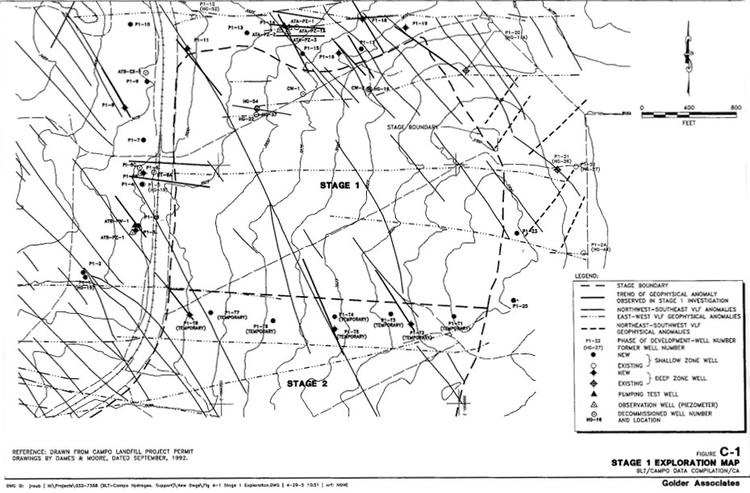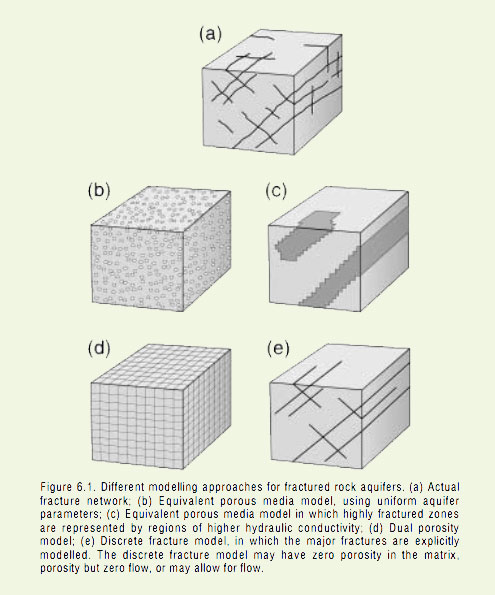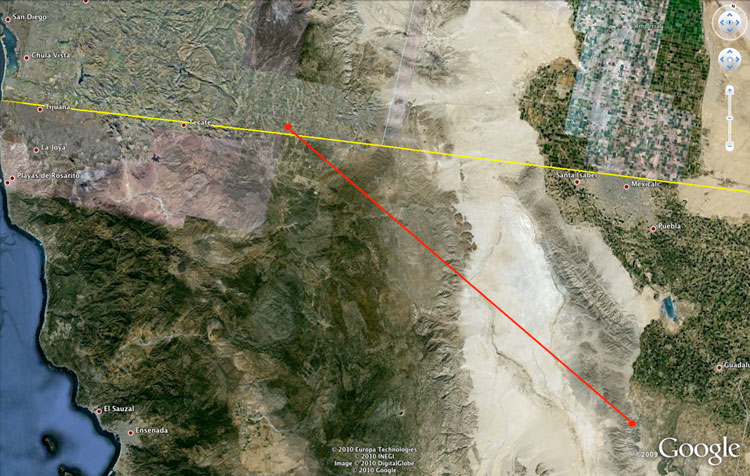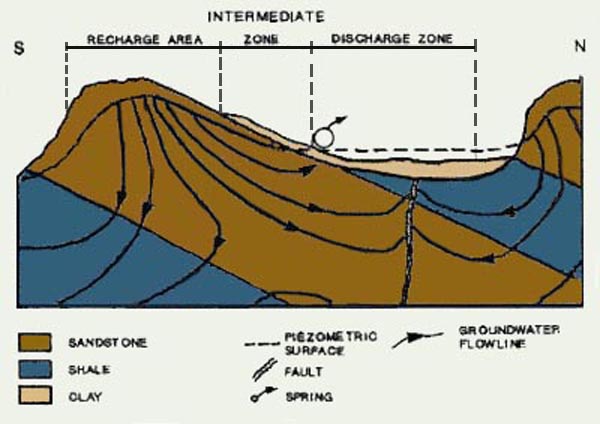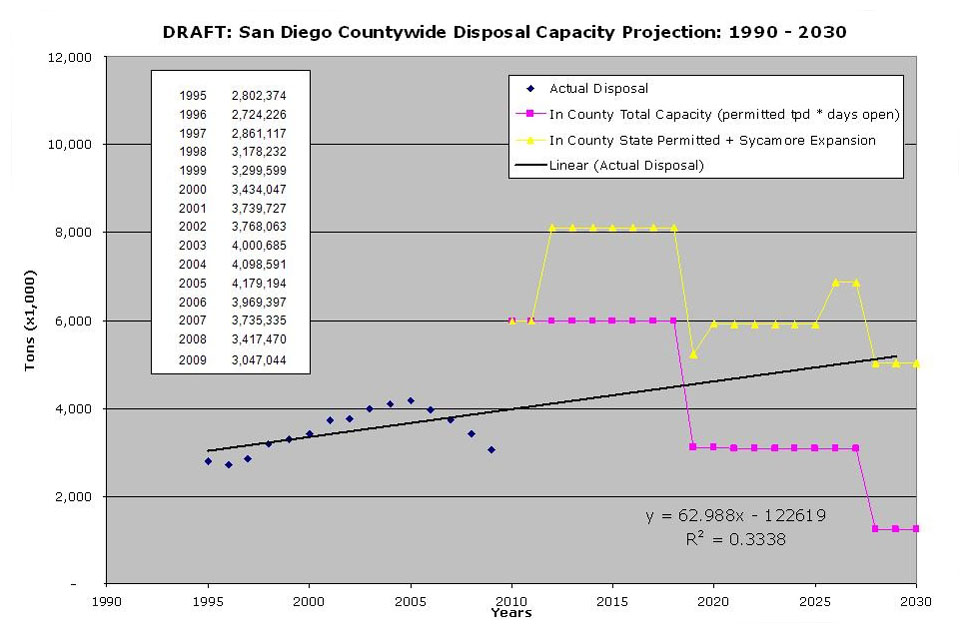|
DRAFT SUPPLEMENTAL ENVIRONMENTAL IMPACT STATEMENT
FOR THE PROPOSED
CAMPO REGIONAL LANDFILL PROJECT
COMMENTS
Victor M. Ponce
05 May 2010
|
EXECUTIVE SUMMARY
This document provides comments to the Draft Supplemental Environmental Impact Statement (DSEIS) for the proposed
Campo Regional Landfill Project. The DSEIS was prepared by the Bureau of Indian Affairs in cooperation with the
Campo Band of Mission Indians, the Campo Environmental Protection Agency, and the U.S. Environmental Protection Agency.
This document is organized into various headings.
Headings are organized topically to comment on major issues raised by the DSEIS.
The siting of the Regional Campo landfill on top of a fractured rock aquifer,
barring adequate characterization of the fractured rock system, and without appropriate monitoring
to prevent contaminant leakage beyond the landfill
perimeter, threatens the quality of life of nearby residents.
The federal designation of the Campo-Cottonwood Creek aquifer, which includes the Tierra del Sol aquifer, as sole source
means that if this aquifer
becomes contaminated, there are no reasonably available sources of water.
No feasible alternative sources of water have been identified in the DSEIS.
The siting of the landfill, surrounded by private lands on three sides, and in close proximity to the U.S.-Mexico border,
implies that the Campo reservation is unwilling to take the risk that they claim, is small.
Instead, the decision has been made to pass most of the risk along to its neighbors.
|
1. INTRODUCTION
The Bureau of Indian Affairs
has prepared a Draft Supplemental Environmental Impact Statement (DSEIS)
for the proposed Campo Regional Landfill Project, to be located on the Campo Indian Reservation in San Diego
County, California. The DSEIS was made public on February 26, 2010.
A 75-day public comment period has been provided. The 75-day public comment period expires May 12, 2010. This document provides comments to the DSEIS.
2. CHOICE OF SITE
The Campo Indian Reservation comprises 16,000 acres in southeastern San Diego County,
close to the United States-Mexico border.
Its southern boundary lies at a distance of 0.4 miles from the border (Bureau of Indian Affairs, 2010).
The project site consists of a 1,150-acre parcel located on the southeastern end of the reservation.
The actual landfill footprint is a 493-acre site on a 1-mile-wide narrow strip bound on three sides
by neighboring private lands (Fig. 1).

|
Fig. 1 Location of Campo Indian reservation, with proposed landfill at the southeast end
(Bureau of Indian Affairs, 2010).
The chosen project site maximizes the impact on adjoining private lands while minimizing
the impact on the Campo Indian reservation.
Given the geographical outline of the reservation, and
because the landfill site constitutes only 3% of the total reservation area, any other alternative site, within the reservation,
would have in effect minimized the impact on private lands.
The risk of aquifer contamination due to landfill leakage remains a distinct possibility.
A state-of-the-art landfill engineering design may contribute to reduce this risk;
however, this risk reduction holds true for any site.
Thus, the choice of site implies that the project places most of the risk on adjoining private property
rather than on reservation land.
The DSEIS endorses, without further review, the Final Environmental Impact Statement (FEIS) of November, 1992
(Campo Indian Reservation, 1992b).
According to the FEIS, the proposed site has been chosen over two other alternatives
because of the following reasons (Bureau of Indian Affairs, 2010; p. 2-40):
- It is adjacent to the existing railway,
- It does not have any upstream drainage area,
- It has less impact on oak woodlands,
- It has less impact on [reservation] cultural resources, and
- It is in conformance with the Campo land use plan.
The DSEIS states that the railway will no longer be used for hauling trash; thus, Reason 1 is no longer valid.
The DSEIS states that the other four reasons (2, 3, 4, and 5) remain valid.
In particular, Reason 2 merits elaboration here. Unlike other alternatives,
the proposed location, on the headwaters of Lower Campo Creek, is an important recharge zone for groundwater.
Thus, groundwater quantity will be substantially impacted due to denied recharge (see Section 10).
As Fig. 1 clearly shows, the landfill project
will also affect reservation land and water resources downstream of the site, specifically in the Lower Campo Creek watershed.
Therefore, many of the comments of this report regarding possible negative impacts to its immediate neighbors, are also applicable to reservation land (see Sections 5 and 8).
3. FRACTURED ROCK AQUIFER
The proposed Campo Regional Landfill Project is underlain by a fractured rock aquifer belonging to the
Peninsular Range batholith.
It is well known that fractured rock aquifers differ from sedimentary aquifers in the following three important respects:
- Water and associated contaminant plumes
travel faster in fractured rock aquifers, primarily by convection through fractures,
- Water and plumes travel directionally along the fractures, in one or two dimensions,
- The fractures may change direction unexpectedly, defying precise characterization.
Thus, landfill projects in fractured rock aquifers must be subjected to close scrutiny.
Geophysical investigations may reveal the characteristic
features of the prevailing fracture
system, but some uncertainty will always remain.
If possible, siting a landfill on top of a fractured rock aquifer should be avoided.
This is due to:
-
The shorthened plume travel times provided by flow convection through fractures, and
- The uncertainties in characterizing
fractured rock aquifers.
According to the U.S. Code of Federal Regulations (U.S. CFR, Title 40, Chapter 1, part 258.51 2006),
a groundwater monitoring system must be installed in a municipal landfill.
The system must consists of a sufficient number of wells to yield groundwater samples that represent
the quality of groundwater to ensure
detection of groundwater contamination. Yet in a fractured rock aquifer on a headwater region (in this case, the top of a hill),
the downgradient direction is uncertain, requiring that monitoring wells be placed at appropriate intervals surrounding the facility.
This is clearly not the case at the proposed Campo landfill.
4. DIRECTION OF WATER AND PLUME MOVEMENT
The fractured rock aquifer underlying the proposed Campo landfill consists
of unweathered to slightly weathered cristalline tonalites.1
These are overlain by (1) a layer of highly weathered tonalites,
and (2) recent alluvial materials on or just below the surface.
The depth to the unweathered to slightly weathered
tonalites varies from 70 to 132 ft (Bureau of Indian Affairs, 2010; p. 3.1-2).
The Campo landfill site features an extensive array of photogeologic lineaments, many of which have a predominant west-east direction;
see Fig. 2 (Ponce, 2006).2
The actual landfill footprint has been carefully positioned to be fully contained within the Lower Campo Creek watershed,
avoiding surface drainage to the
Tierra del Sol watershed located immediately east of it.
Yet, by design, the distance from the eastern end of the landfill footprint to
the western limit of the Tierra del Sol watershed (red line in Fig. 2) is extremely short, in some cases, only a few feet.
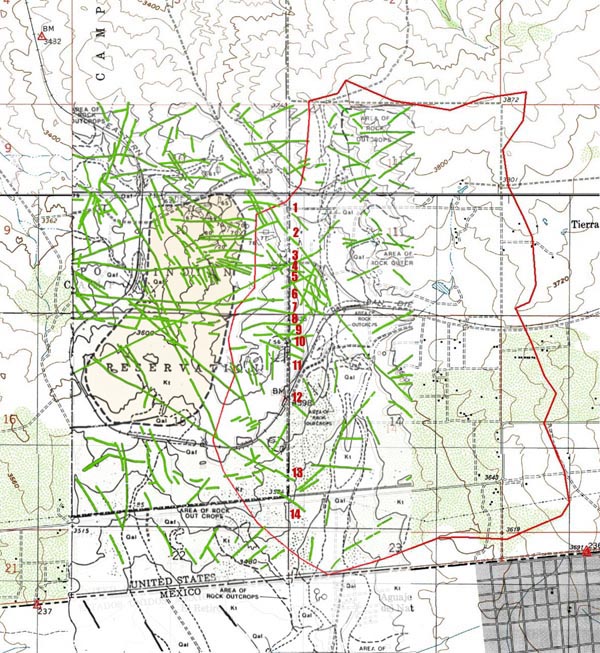
|
Fig. 2 Existing photogeologic lineaments in the vicinity of the Campo landfill site
(Numbers show lineaments
crossing landfill boundary from west to east)
(Ponce, 2006).
Five major lineaments cross from the landfill footprint from west to east and are clearly visible from
the air; see Fig. 3 (Ponce, 2006).
Given the existing lineaments, there is no guarantee that the subsurface drainage will conform
to the surface drainage. Thus, the case for
plume containment based solely on surface drainage, as implied by the DSEIS in their siting design, is open to question.
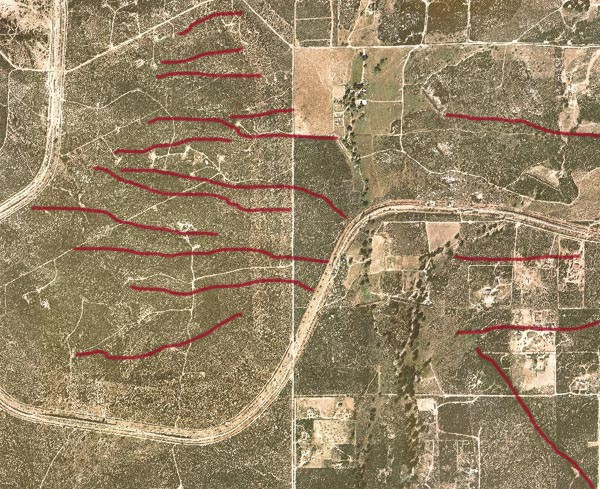
|
Fig. 3 Major photogeologic lineaments in the vicinity of the Campo landfill site
(Ponce, 2006).
The existence of a connection in the regional groundwater flow below the landfill and its eastern neighbors is
confirmed by a groundwater flow direction map
prepared by the landfill consultants for the original EIS (Fig. 4) (Campo Indian Reservation, 1992a).
This figure shows arrows also pointing east and south, indicating that groundwater flow may move east toward Tierra del Sol, and south
toward Roca Magisterial, in Mexico.
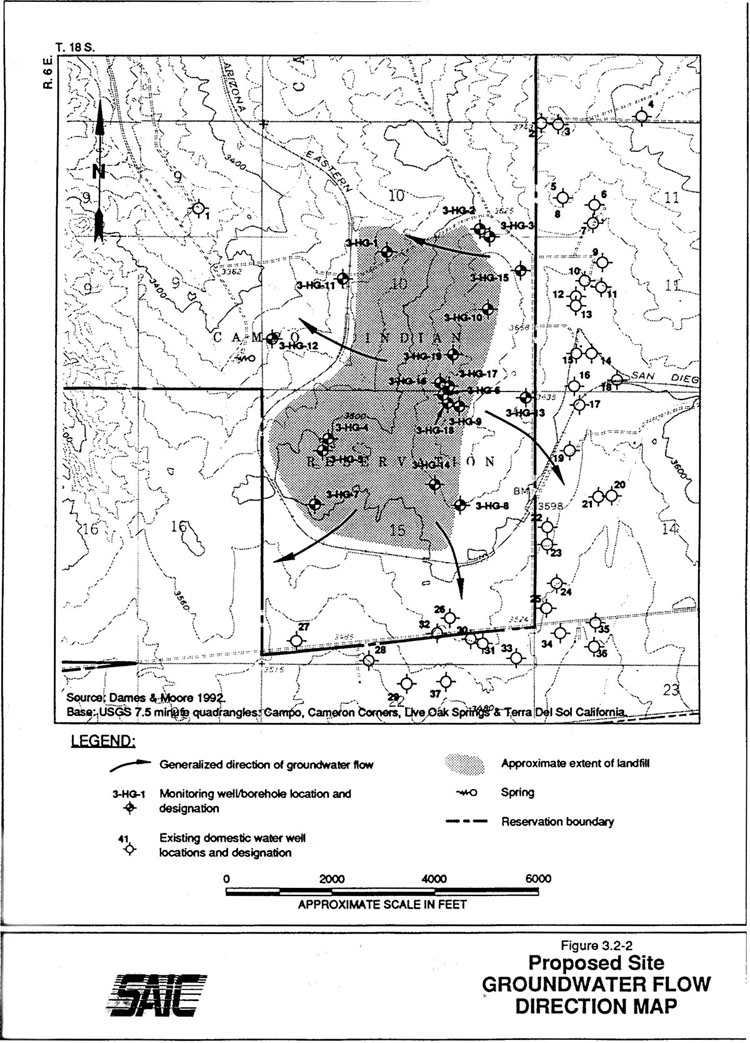
|
Fig. 4 Proposed site groundwater flow direction map
(click on figure to enlarge)
(Campo Indian Reservation, 1992a).
5. MONITORING WELLS
Figure 5 shows the network of monitoring wells proposed for phases 1-3 and 17-19 of the landfill project.
The project plans to develop a similar network for other phases prior to their construction (Bureau of Indian Affairs, 2010).
Figure 5 shows that the distance between wells varies between 200 feet on the west side of the landfill
to 500 feet on the east side.
The total number of monitoring wells on the east side is four.
For the expected values of transverse dispersion,
plume widths will be on the order of 100 feet (Bureau of Indian Affairs, 2010; Appendix C-4, p. 31).
The DSEIS states that the expected spacing for monitoring wells should be on the order
of the expected transverse dispersion of the plumes, i.e., 100 feet (Bureau of Indian Affairs, 2010; Appendix C-4, p. 31).
Thus, the proposed number of monitoring wells along the east side is judged to be grossly insufficient.
Contaminant plumes will most likely be missed by the scant number of wells on the east side, where neighbor concern is
the greatest.

|
Fig. 5 Proposed network of monitoring wells for phases 1-3 and 17-19 (click on figure to enlarge)
(Bureau of Indian Affairs, 2010).
The absence of a detailed plan for east-side well monitoring for nearly two-thirds of the landfill footprint
is a serious omission of the DSEIS. As currently conceived, the plan is expected to provide monitoring wells
at a distance of 500 feet on the east side. This is insufficient, and a cause for grave concern regarding
the project's responsibility to its neighbors.
The DSEIS considers it very unlikely that leaks will occur in both the primary and
secondary liners in the same area (Bureau of Indian Affairs, 2010; p. 2-15).
A double-liner system is generally judged to be safer than a single-liner system.
Yet, a double-liner system does not completely eliminate the possibility of groundwater contamination.
The rationale for the double-liner system assumes that the primary liner will fail first,
and the leachate will be recovered subsequently, before it is able to reach the secondary liner.
However, there is the distinct possibility that the secondary liner will fail first, with the breach remaining undetected, with
no plume to track down, until the primary liner fails.
The DSEIS considers monthly inspections of the liner system to detect leaks. Leaks would be analyzed to determine the need for remedial action,
including redirection of landfill activities and even early closure of a phase (Bureau of Indian Affairs, 2010; p. 2-8). Thus, the possibility of
liner leakage and aquifer contamination remains.
In terms of monitorability, the DSEIS does not add significantly to the previous Campo landfill project
(Campo Indian
Reservation, 1992a; 1992b). On January 4, 1993, the Environmental Protection Agency (EPA) rated the DEIS as EO-2 -- Environmental Objections --
Insufficient Information.3 The letter stated that the rating was based on the belief that
"compliance with groundwater monitoring and corrective action required by federal criteria
(40 CFR Part 258) could prove difficult or unfeasible in the geologic setting of the proposed landfill." Thus,
the issue of the site's unmonitorability remains.
A significant concern, not addressed in the DSEIS, is the practical difficulty of restoring a fractured rock aquifer that has been
contaminated. The contaminated water tends to diffuse into the rock matrix's stagnant pore water, increasing the difficulty of
cleanup.
While the cleanup problem is more serious in sedimentary rock aquifers,
even in crystalline rocks the attainment of very high levels of water quality may be problematic (Mutch et al., 1991).
Another source of concern is the possible mobilization of elements or compounds contained in the sediments and rock, as a result
of the geochemistry of the leachate plume. For example, in the Saco Municipal
Landfill near Saco, Maine, a plume of arsenic
with concentrations as high as 700 micrograms per liter has been
documented (U.S. Geological Survey, 2008).
Studies of the geochemistry
of the leachate plume at this landfill have shown that the source of the arsenic is not the landfill, but appears to be the sediments
the plume is moving through. USGS has shown that dissolved organic carbon in the leachate plume
is dissolving arsenic from arsenic-containing iron oxides in the aquifer and bedrock.
The dissolution occurs because the degradation of the dissolved organic carbon in the plume removes
oxygen from the water and creates reducing conditions that favor the dissolution of iron oxides and the
release of arsenic from the sediments.
6. TRAVEL TIME
The travel time is the time it takes a contaminant plume to show up in neighboring wells.
The travel time is a function of the advective velocity through fractures.
The larger the advective velocity, the shorter the travel time.
The DSEIS states that the greatest volume of groundwater storage occurs in the shallower, more porous weathered tonalite,
but flow velocities may be highest through joints and fractures in the deeper, less weathered and unweathered tonalite.
The DSEIS recognizes that
groundwater flow systems within the shallower weathered tonalite and the deeper unweathered tonalite
fracture system are likely to be interconnected (Bureau of Indian Affairs, 2010; p. 3.2-6).
The DSEIS states that tracer tests resulted in estimated seepage velocities of 3.6 to 9.0 feet per day.
They also reported that the fractured rock system is anisotropic, with horizontal velocities likely to be an order of magnitude greater
than vertical velocities. Thus, groundwater flows more readily horizontally than vertically (Bureau of Indian Affairs, 2010; p. 3.2-8).
In fractured rock aquifers such as that of the proposed Campo landfill,
the advective velocities may be on the order of hundreds of feet per day,
which is equivalent to
the hydraulic conductivity of the most permeable gravels.4
These fracture zones of high advective velocity are very narrow and difficult to
detect, yet they transport most of the solute mass away from the landfill. Monitoring wells would have to intersect
these fractures in order to detect any contamination. Given the proposed distance of 500 feet between wells, it is very unlikely
that a plume within a given fracture will be detected by the small number of monitoring wells.
The short travel time of groundwater flow in the vicinity of the Campo landfill is confirmed by
local experience. In 1991, Tierra del Sol neighbors experienced the occurrence of sand and salty water in their wells, at about the same time
that Dames and Moore, the original landfill engineering consultant, was performing exploratory drilling on the
site.5,6
The apparent cause-effect relation between the drilling on the Campo landfill site and the sanding and salty water on neighbors' wells
should be a cause for concern.
Solute transport in a fractured rock aquifer will be predominantly advective, with little diffusion of the contaminant plume.
Thus, concentrated leachates will travel long distances quite rapidly, in unforeseen directions.
It is almost impossible to guarantee containment in all circumstances. While it is technically feasible
to reduce the distance between monitoring wells to implement a line of defense resembling a picket fence,
the cost would be prohibitively high. Moreover, such a high well density, if implemented, is likely to
change the local hydraulics and do more harm than good in the long run. This is because a borehole acts
as a high-permeability pathway that connects fractures
which previously were unconnected, as shown by USGS experience (Shapiro, 2001).
7. GROUNDWATER CHARACTERIZATION
The DSEIS groundwater characterization and modeling programs is Appendix C-4 of the DSEIS (Bureau of Indian Affairs, 2010).
Distinct fractures are observed at various depths within the upper and lower tonalites. The zones of
weathering associated with the identified features may be two to three feet in thickness (Bureau of Indian Affairs, 2010; Appendix C-4, p. 12).
The DSEIS recognizes that there are several west-east lineaments crossing the Campo landfill site toward private lands along the east.
These lineaments, shown in Fig. 6, were originally identified for the FEIS
(Bureau of Indian Affairs, 2010; Appendix C-4: Appendix C, Figure C-1) (Campo Indian Reservation, 1992b).
They have been recently confirmed by Ponce (2006) (Fig. 3).
Fig. 6 East-west photogeological lineaments on the Campo landfill site (click on figure to enlarge)
(Bureau of Indian Affairs, 2010; Appendix C-4).
The proven existence of these lineaments raises a significant concern that a landfill leak may reach private lands
immediately east of the landfill. The DSEIS states that the most prominent fractures strike NNW, with moderate to shallow dips to the SW.
Yet other fractures strike ENE to WNW, with moderate to steep dips to the N and S (Bureau of Indian Affairs, 2010; Appendix C-4, p. 12).
The Campo landfill site and the adjoining Tierra del Sol watershed lie on extensively fractured rock.
A typical fracture in a rock outcrop in the Tierra del Sol watershed is shown in Fig. 7.
Significantly, a correlation exists between the location of these fractures and the presence of certain floristic indicators.
Two vegetative species, red shank (Adenostoma sparsifolium) and blue eldelberry (Sambucus mexicana)
are known to have affinity with water.
Their distribution in the Tierra del Sol watershed has been linked to the presence of the fractures
(Ponce, 2006).
The fractures can support vegetation that otherwise would not be there; therefore,
it can be concluded that the fractures conduct substantial amounts of water.
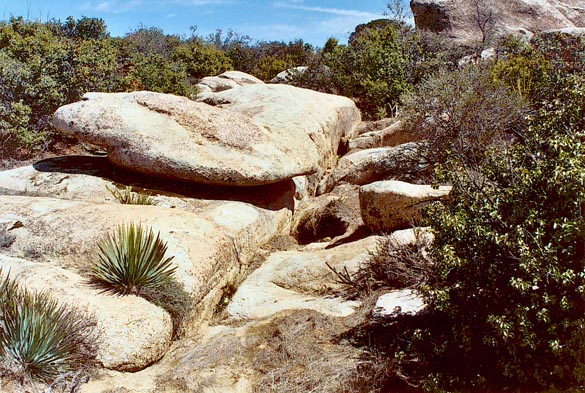
|
Fig. 7 Fracture in rock outcrop in Tierra del Sol watershed,
adjoining the Campo landfill site.
The tonalite
bedrock in the vicinity of the Campo landfill site features many pegmatitic dikes, typically granitic in mineralogical composition,
which are exposed locally (Bureau of Indian Affairs, 2010; p. 3.1-2). One such dike, of large size, is shown in Fig. 8,
with its location shown in Fig. 10 (Ponce, 2006).
This 1,465 feet-long dike ends in its western extremity in a spring,
which supports a rather large isolated specimen of coast live oak (Quercus agrifolia) (Fig. 9).
Note the pool of water (spring) near the base of the oak tree.
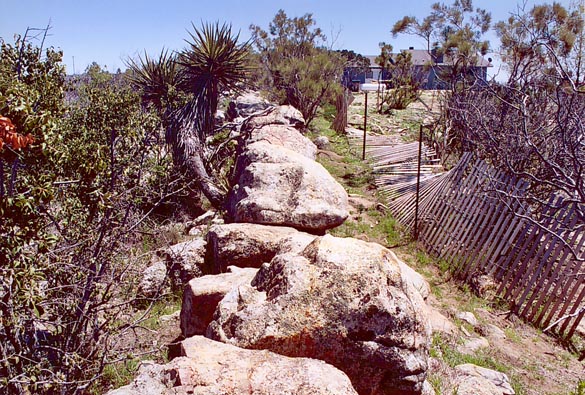
|
Fig. 8 Large pegmatitic dike in Turner Ranch, in the Tierra del Sol watershed.
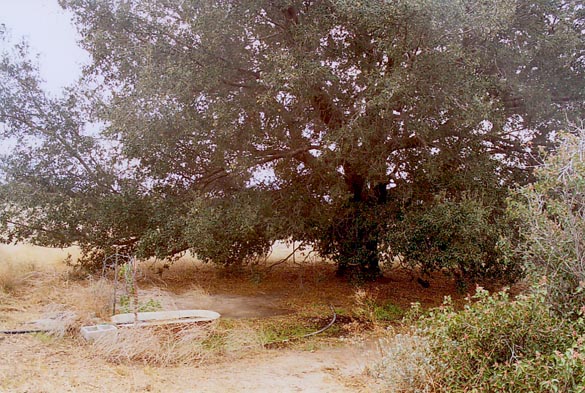
|
Fig. 9 Spring at the western (downstream) end of large dike in
Tierra del Sol watershed, adjoining the Campo landfill site.
The numerous springs which dot the Tierra del Sol watershed and surroundings have been discussed by
Ponce (2006), and featured in the video
Tierra del Sol fights for clean water (Visualab Productions, 2009).
Figure 10 shows the location of eleven (11) springs that have been documented in the Tierra del Sol watershed.
One such spring is located less than 1,500 feet from the landfill footprint.
As shown in Fig. 10, springs indicate the downstream location of geologic features such as
fractures or dikes (straight red line in this figure) intersecting the ground surface.
Figure 11 is a close-up of one of the springs documented in the Tierra del Sol watershed.
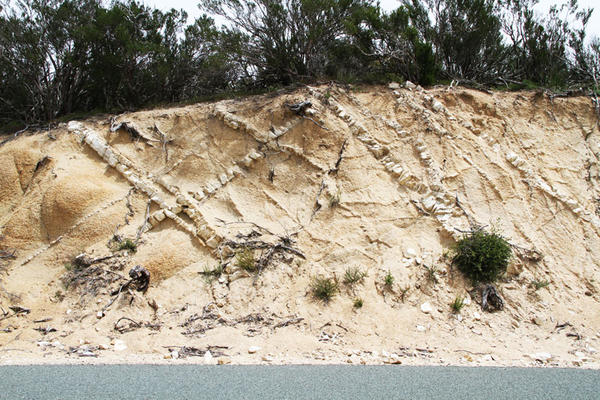
|
Fig. 10 Springs and dike documented in the Tierra del Sol watershed
(Ponce, 2006).
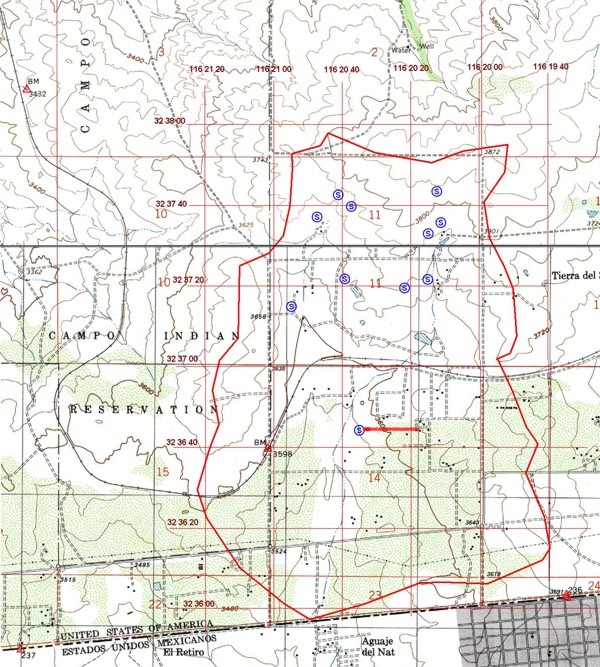
|
Fig. 11 Close-up of a spring in the Tierra del Sol watershed
(Ponce, 2006).
8. GROUNDWATER MODELING
Appendix C-4 of the DSEIS describes the hydrogeologic conceptual model of the Campo landfill site
(Bureau of Indian Affairs, 2010; Appendix C-4, p. 24).
The current model differs in some primary respects from the original model developed for the FEIS,
but appears to retain the equivalent porous media (EPM) modeling concept,
while considering the most significant fractures; see Fig. 12 (c).
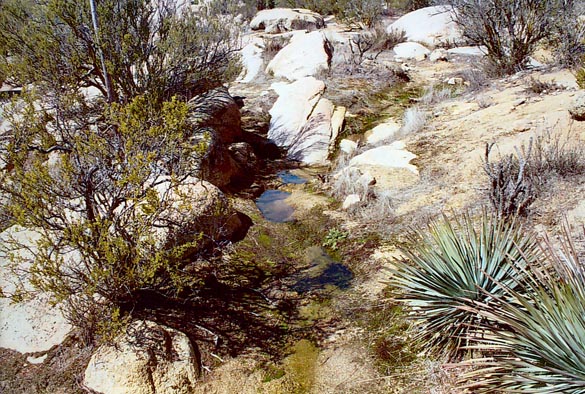
|
Fig. 12 Alternative approaches for modeling fractured rock aquifers
(Cook, 2003).
The DSEIS identified major topographic lineaments that act as drains for the regional flow system to the
west (Bureau of Indian Affairs, 2010; Appendix C-4. p. 27). Drainage to the east, as documented by Figs. 3 and 6,
was either not found or not considered.
Generally speaking, constituent flow modeling works well in situations where the source of the
contaminant plume is well defined, not only in time
and space, but also in chemical composition and concentration.
However, in landfill-leakage modeling, the situation is complicated by the
unknown and unpredictable nature of the offending leachate plume.7
Thus, biogeochemical transport modeling of
contaminant plumes following landfill leakage is nothing more than an educated guess.
In addition, the lack of site-specific biogeochemical transport data precludes a meaningful model calibration.
9. JURISDICTIONAL WATERS OF THE UNITED STATES
The proposed access road to the Campo landfill would cross Campo Creek, which is classified as a blue-line, intermittent stream
by the U.S. Geological Survey (Bureau of Indian Affairs, 2010; p. 3.2-4). The U.S. Army Corps of Engineers typically decides on a
case-by-case basis whether or not to classify creeks as jurisdictional waters in association with construction projects.
Campo Creek may be considered a jurisdictional waterway because it is such a prominent creek in the project vicinity.
A final determination will have to be made by the U.S. Army Corps of Engineers.
Figure 13 shows the intersection of Campo Creek with State Route 94.
A short distance downstream of this location, at the intersection with Diabold Canyon Creek,
the Campo Creek watershed measures 11.53 square miles (Ponce, 2005).
Through this region, Campo Creek is an intermittent stream with flash flood capability.
The access road to the proposed Campo landfill crosses Campo Creek a short distance upstream from the intersection with
State Route 94 (Fig. 13).
A similar structure to that shown in Fig. 13 may be required for the access road.
The proposed culverted Arizona crossing may be inoperable in times of flood, precluding full access to the site.
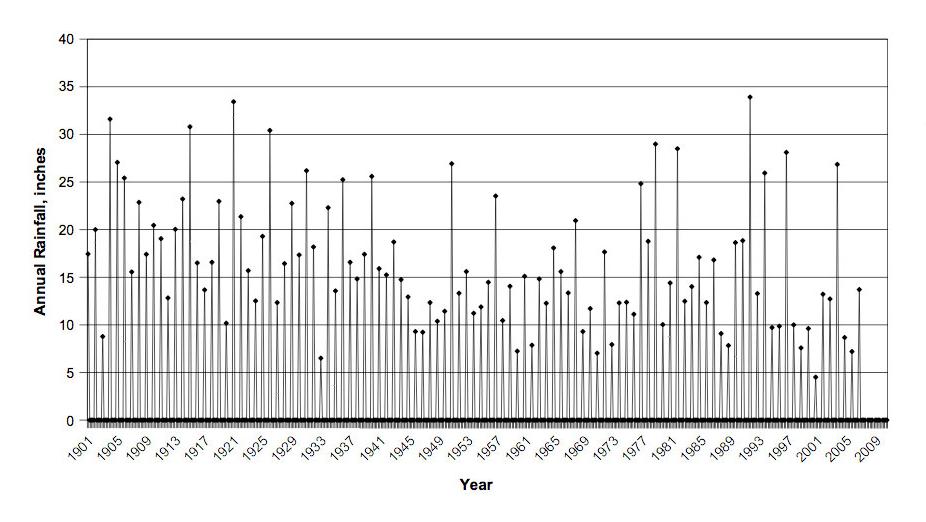
|
Fig. 13 Culvert crossing at intersection of Campo Creek with State Route 94,
San Diego County (Ponce, 2005).
10. DENIED RECHARGE
Groundwater is naturally recharged upstream and discharged downstream.
Recharge areas are close to mountain peaks, where precipitation is likely to be higher than in the adjacent lowlands.
Shallow groundwater discharges in the valleys and other low-lying zones (Fig. 14). While typical downgradients
under matrix throughflow resemble the surface topography, downgradients under fractured rock may not. To be precise,
water balances in fractured rock aquifers must consider the subsurface connectivity and the possibility of leaks to neighboring basins.
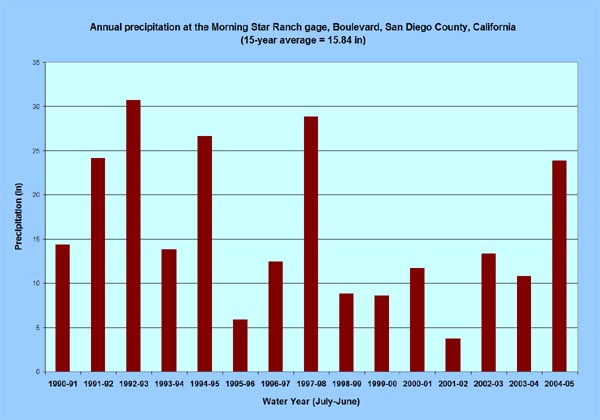
|
Fig. 14 Typical recharge and discharge in groundwater systems.
The Campo landfill project is located in the headwaters of Lower Campo Creek, immediately west of the Tierra del Sol watershed,
which drains elsewhere, into Mexico. Thus, the project will compromise groundwater replenishment in the area by denied recharge.
Denied recharge refers to the reduction in groundwater replenishment
due to project operations, as a result of the redirection of surface-water runoff,
from the landfill surface to basins along its perimeter. Declines in groundwater level have been estimated
at 4 to 27 ft (Bureau of Indian Affairs, 2010; p. ES-13). This redirected discharge will increase groundwater levels
at and immediately downgradient from the recharge basins, toward Lower Campo Creek.
Under normal, through-the-matrix surface-groundwater interaction, a water balance will show very little loss of water by the forced
redirection of surface waters and the change in location of groundwater replenishment. However, under a fractured rock aquifer,
where the true downgradient direction cannot be readily ascertained, the denied recharge (and redirected through surface downgradient)
may effectively
reduce the rate of recharge in
neighboring wells to the east. The closest domestic private well lies at about 1,500 feet from the edge of the landfill footprint,
making the impact too close to call.
11. SOLE SOURCE AQUIFER
The Campo-Cottonwood Creek Sole Source Aquifer was designated as such on May 5, 1993,
under the authority of Section 1424(e) of the Safe Drinking Water Act (Federal Register Citation-49 FR 2948,
January 24, 1984). An aquifer can be named a Sole Source Aquifer by the Administrator of the
Environmental Protection Agency if the aquifer supplies 50% or more of the drinking water for
an area and there are no reasonably available alternative sources should the aquifer become contaminated.
There is a difference between the mitigation measures offered between the FEIS and the current DSEIS.
The previous project included a property value protection guaranteeing alternative water sources for 20 years (Bureau of Indian Affairs, 2010, p. ES-14).
The current project contains a mitigation measure requiring the operator to provide water to any domestic user whose source is compromised
by project operations, in quantity or quality, for the duration of the compromised condition. Yet there are no readily identified
and cost-effective alternative sources of water supply to be found in the vicinity. It will cost close to U.S $ 200 million
(in 1993 dollars) to pipe in water from outside the region,
and no water is available.8
The DSEIS describes the plan to establish a program for sampling of off-site domestic wells within the
project area (Bureau of Indian Affairs, 20-10; p. 4.2-31).
This is for the purpose of establishing background water quality to assess water quality impacts, should a release from the facility
occur.
Yet there is no clear indication of where the replacement water would be coming from.
In essence, the project commits to provide alternative water in the event of groundwater contamination, but it does not
state clearly where or how the additional water is going to come from.
12. WASTE STREAM
The DSEIS states that the project would compete for solid waste disposal
contracts within San Diego County and the surrounding region (Bureau of Indian Affairs, p. ES-4).
The DSEIS also states that the landfill could accept approximately 14-15 percent of the total San Diego County
waste stream (Bureau of Indian Affairs, 2010; p. 1-1; p. 2-2).
Yet it appears that it has no firm contracts to date. The site is located 60 miles from the city of San Diego; thus, Miramar
and other county landfills are nearer to the source of waste.
Every five years, the County of San Diego updates its
Integrated Waste Management Plan. The current review cycle
is in progress, with a final document expected September 2010 (County of San Diego, 2010).
A draft chart of the disposal capacity projection is shown in Fig. 15.9
In this graph, the capacity projection (in million tons per year) includes the county
landfills at Miramar, Otay, Sycamore, and Borrego Springs.
It does not include the proposed county landfill at Gregory Canyon
and the proposed non-county Campo landfill. As Fig. 15 shows, sufficient
landfill capacity is currently projected in San Diego County until 2028.
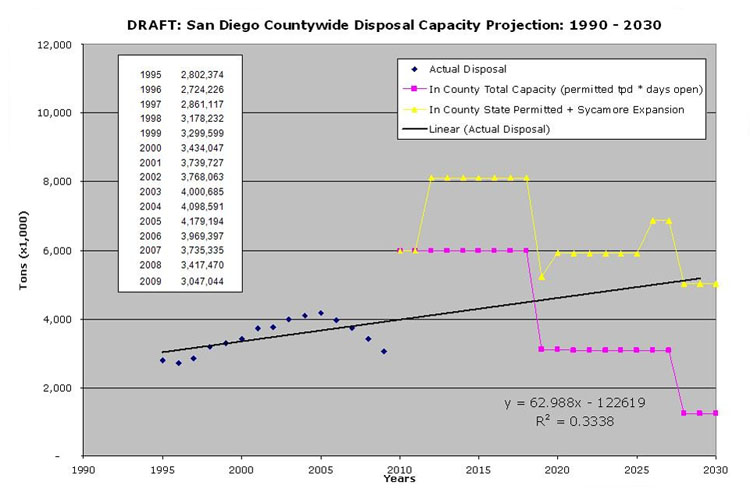
|
Fig. 15 County of San Diego disposal capacity projection 1990-2030
(County of San Diego, 2010)
The State of California has a policy of zero solid waste. Acting on this policy,
several bills have been submitted recently to the State Legislature
to reach a 75% diversion level.10
The San Diego County Board of Supervisors,
the San Diego Association of Governments (SANDAG), and the
State of California have officially recognized that a 75% diversion rate in San Diego County
would significantly reduce the need for additional
landfills over the next several decades.
It is seen that the current countywide solid waste
trend is in the direction of greater diversion.
Therefore, to remain in business, the Campo landfill will have to import waste from much farther sources
and, at that point, may have to consider receiving other types of wastes, including special wastes.11
All the while, its carbon footprint will be significantly increased, and the
original plan--to receive municipal wastes--will be substantially altered.
Figure 15 shows a sharp decrease in
actual disposal
tons, starting in 2005. This reflects both the economic downturn
and the fact that in the past five years, San Diego County has been making great strides to comply with the state-mandated
directive to: (1) reduce, (2) reuse, (3) recycle, and (4) transform, as a sustainable alternative to landfilling.
The trend toward a reduction in disposable solid waste is already a reality in San Diego County.
The objective is to reduce the need for disposable
solid waste either to zero, or to a negligible amount, in effect preempting the need for
additional landfills. Landfills could pose a significant threat to the surrounding
environment, as the specific case of Campo clearly shows.
Thus, the only sensible course of action is to avoid or minimize the need for them.
The proposed Campo landfill
would have to be permitted to receive county solid waste. Existing regulations require the county to dispose of its solid
waste, after recycling, first by using county facilities, and secondarily, by using non-county facilities.
According to the current plan (2010) and solid waste trends, it is highly improbable that San Diego County would need to
rely on the Campo landfill for its waste disposal needs well into the future.
13. EARTHQUAKE RISK
The vicinity of the Campo landfill site is transversed by several major faults, foretelling
substantial tectonic activity.
Figure 16
shows the recorded earthquakes with magnitudes greater than 4.5
within a 93-mile (150-km) radius from the proposed Campo landfill site (Bureau of Indian Affairs, 2010; p. 3.1-5).
Fig. 16 Earthquakes (1800-2006) greater than magnitude 4.5 and major faults
within 93 miles (150 km)
of Campo landfill (Bureau of Indian Affairs, 2010).
According to the DSEIS, the largest of the historical earthquakes was a Richter 7.1 event that occurred on November 11, 1915,
with its center located 89 miles southeast of the project site (Bureau of Indian Affairs, 2010; p. 3.1-4).
Yet according to the U.S. Geological Survey, the February 24, 1892 earthquake in the Imperial Valley, California, about 50 miles east of the
project site, was of magnitude 7.8.12
The description of the 1892 earthquake by USGS speaks for itself:
"At the old Carrizo station in San Diego County, all adobe buildings were destroyed. In Paradise Valley,
a church and schoolhouse built on stilts were knocked down and demolished; chimneys and plaster
were broken in San Diego. Ground fissures were reported at McCain Valley and Jewel Valley;
rockslides were observed between Campo and Carrizo and at Dulzura and Jewel Valley."
"About 155 tremors were felt at Campo during the 12 hours following the main shock, and aftershocks
continued there every few days into April 1892. Observers reported that 135 aftershocks were felt
as far away as National City, on San Diego Bay. Felt north along the coast to Santa Barbara,
east to Yuma, Arizona, and south to San Quintin, Baja California. One report stated that the
tremor was felt at Visalia, Tulare County, about 700 kilometers north of San Quintin."
Note that Jewel valley, where ground fissures and rock slides were reported, is about 4 miles NE of the proposed landfill site, while Campo
is about 4 miles WNW.13
Thus, the neglect of the February 24, 1892 earthquake, the largest on record, is a serious omission of the DSEIS.
The DSEIS states that the intensity of
the Maximum Credible Earthquake (MCE) ranges from 6.0 to 7.4 in the Richter scale, depending on the originating fault
(Bureau of Indian Affairs, 2010; p. 3.1-6).
Apparently, the 7.8 magnitude earthquake was not considered in the development of the adopted MCE range of 6.0-7.4.
The recent strong earthquake near Guadalupe Victoria, south of Mexicali, Baja California, on
April 4, 2010 at 15:40 PDT, had an intensity of 7.2 on the Richter scale, making it one of the strongest on record.
The epicenter was located about 75 miles southeast from the landfill site (Fig. 17).
Fig. 17 Distance from the epicenter of the 7.2 magnitude earthquake on April 4, 2010
in Baja California,
to the Campo landfill site (click on figure to enlarge)
(Source: Google Earth).
While structural damage was restricted to Mexicali and vicinity, including Calexico and El Centro,
the earthquake was felt throughout San Diego county, including Tierra del Sol, and as far as Phoenix
and Las Vegas.14
The earthquake also cracked the main aqueduct that carries Colorado river water from Mexicali to Tijuana, leaving Tijuana residents
severely limited in the water use.14
Structural damage to a road and bridge approach in Mexicali is shown in Fig. 18.
Structural damage to the Mexicali-Tijuana road at Km 20 near cerro El Centinela is shown in Fig. 19 (a distance of 40 miles
from the Campo landfill).
Fig. 18 Structural damage to road and bridge approach in Mexicali,
as a result of the April 4, 2010 earthquake.15
Fig. 19 Structural damage to the Mexicali-Tijuana road at Km 20, near Cerro El Centinela,
as a result of the April 4, 2010
earthquake.16
The April 4th earthquake shook Southeastern San Diego County
and had significant and measurable effects on its groundwater.
A case in point is the Jacumba Hot Springs
Spa and Lodge, in Jacumba, about 8 miles east of the proposed
Campo landfill.
The facility is supplied by an ancient Native-American well that
furnishes hot, sulphurous water to its swimming pool and jacuzzis.
As a direct result of the excessive
water pressure released by the earthquake and two of its
aftershocks, the well head blew up three times within a period of 24 hours
and had to be repaired each time.17 Clearly,
the connection between groundwater flow and strong earthquakes in fractured rock aquifers
is too significant to be disregarded.
It is entirely possible
that strong earthquakes such as that of April 4th will happen in the region within the expected 60 years of total project life
(30-year operation plus 30-year post-closure monitoring period).
Thus, the wisdom of placing a landfill on a fractured rock aquifer of uncertain characterization,
on top of a hill, near the basin's headwaters,
and in a region prone to major earthquakes is open to question.
14. UNAVOIDABLE SIGNIFICANT IMPACTS
The DSEIS states that there are unavoidable significant impacts associated with the following:
- land use,
- resource use patterns (visual), and
- noise.
According to the DSEIS, no feasible measures exist to fully mitigate land use incompatibility impacts to several
existing nearby residential, civic, and tribal land uses, as well as to nearby off-reservation residential
land uses (Bureau of Indian Affairs, 2010, p. 5-2).
Additionally, despite mitigation measures in place,
visual impacts to off-reservation residences and noise levels will remain significant and unavoidable.
The fact that these significant impacts cannot be mitigated casts questions on the project's viability.
Once completed, the landfill site will increase the average ground elevation by about 100 ft, as shown in Fig. 20
(Bureau of Indian Affairs, 2010; p. 2.37). This is a direct result of placing the landfill on the headwaters of Lower Campo Creek,
where it can be seen from all nearby areas, particularly from the east.
It is noted that the vertical distance of 100 feet represents the height of an 10-story building.

|
Fig. 20 New ground level after landfill closure (click on figure to enlarge)
(Bureau of Indian Affairs, 2010).
The DSEIS fails to recognize an unavoidable and unmitigated significant impact to the water quality of neighboring private lands.
It is only a matter of time before the liners will leak. It is almost impossible to implement appropriate monitoring in a
fractured rock aquifer. In the event of contamination, water would have to be piped from long distances.
The availability, quality, and cost of this water transfer has not been fully explained in the DSEIS.
15. TRANSBOUNDARY IMPACTS
The distance from the Campo landfill to the United States-Mexico border is about 0.8 mile.
The watershed immediately to the east of the site, comprising the community of Tierra del Sol,
drains into Mexico through Aguaje del Nat, by Roca Magisterial,
and about 0.6 mile west of the community of Jardines del Rincon
(the shaded area at bottom right of Fig. 21).18

|
Fig. 21 Delineation of the Tierra del Sol watershed, immediately east
of the Campo landfill site (Ponce, 2006).
The DSEIS states that the potential for surface water contamination reaching Campo Creek and then being transported into Mexico
is very small (Bureau of Indian Affairs, 2010; p. 7-3). Yet the DSEIS does not address the potential for groundwater contamination
reaching Mexico by leakage through and under the Tierra del Sol watershed.
Leakage originating in the landfill site is expected to make its way to the neighboring Tierra del Sol drainage
through subsurface fractures, and move downstream into Mexico (see Fig. 4). Thus, contaminant plumes from leaking liners, undetected by the
scant number of monitoring wells, have a high probability of crossing the border within a relatively short time.
Thus, errors and omissions will have a transboundary impact.
There is absolute certainty that
the springs in Aguaje del Nat originate from upstream sources in Tierra del Sol and vicinity.
On April 8, 2010, a field inspection revealed that there are two gullies immediately south of the border, where Tierra del Sol creek drains into
Mexico.
The larger gully averaged 4 ft deep and 16 ft wide (Fig. 22), and the smaller one, about 3 ft deep and 6 ft wide.
At a short distance downstream, the gullies join to form a small stream.
On the day of the inspection, the flow of this stream was
estimated at 8 gallons per minute (0.5 liters per second).
The presence of a well and a small concrete dam and pond shows that the water in this stream has been or
is being utilized for domestic consumption.
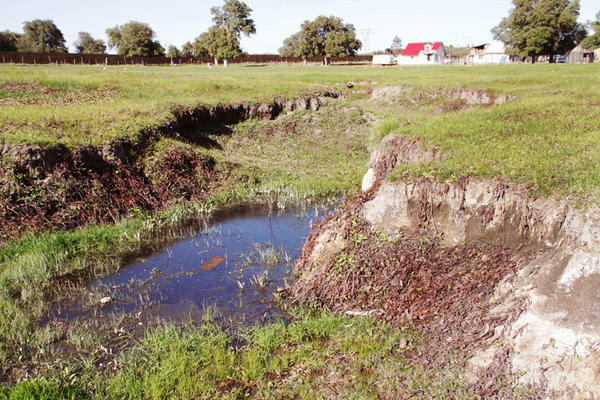
|
Fig. 22 Aguaje del Nat at Roca Magisterial, south of Tierra del Sol,
immediately downstream of the United States-Mexico
border fence, shown in the background.
On June 20, 1994, the Mexican Embassy in Washington, D.C., issued Diplomatic Note No. 889, in reference to the planned installation
of a municipal landfill in the Campo Indian reservation. The document states that contamination
of the transboundary network of underground streams would create significant harm to the public health, particularly
in the nearby community of Jardines del Rincon. Once the contamination has occurred, the inability
to accurately predict its path precludes any guarantee that a contaminant plume that has penetrated the soil could be eliminated before,
or even after, it enters the network of streams (U.S. Department of State, 1994).
It is noted that the Campo landfill project runs counter to existing binational agreements. In 1983, the United States and Mexico
signed the La Paz Agreement on Cooperation for the Protection and Improvement of the Environment in the
Border Area. The border area is defined as the 100-km strip of land adjacent to the physical border. The Campo landfill
is clearly within this border area.
In Article 1 of the La Paz agreement, the U.S. and Mexico agree to cooperate
in the field of environmental protection in the border area on the basis of
equality, reciprocity, and mutual benefit. In Article 2, the parties agree to adopt the appropriate measures to prevent,
reduce and eliminate sources of pollution in their respective territory which affect the border area of the other.
Given the practical impossibility of an effective monitoring of a landfill entombment
on top of a fractured rock aquifer, the Campo landfill project has yet to
prove that it is technically sound and politically viable.
16. SUMMARY
The siting of the Regional Campo landfill on top of a fractured rock aquifer,
barring adequate characterization of the fractured rock system, and without appropriate monitoring
to prevent contaminant leakage beyond the landfill
perimeter, threatens the water resources and the quality of life of nearby residents. No amount of reasonable monitoring can exclude
the possibility of liner failure and subsequent groundwater contamination.
The proposed project may account for surface runoff; however, subsurface flow in a fractured rock aquifer
defies characterization and absolute certainty. Thus, aquifer contamination remains a distinct possibility. Furthermore, liners, no matter how
thick and well constructed, do have a finite service life.
The 30-year after-closure mandated monitoring period is too short to adequately protect residents from contamination of their water supply
into the future.
Once the groundwater has become contaminated, it will be difficult to remediate.
The contaminated water may tend to diffuse into the rock matrix's stagnant pore water, increasing the difficulty of cleanup.
Another source of concern is the possible mobilization of elements or compounds contained in the rock,
as a result of the geochemistry of the leachate plume.
The absence of a detailed plan for east-side well monitoring for nearly two-thirds of the landfill footprint
is a serious omission of the DSEIS. As currently conceived, the plan is expected to provide monitoring wells
at a distance of 500 feet on the east side. This is insufficient and a cause for grave concern regarding
the project's responsibility to its neighbors.
The federal designation of the Campo-Cottonwood Creek aquifer, which includes the Tierra del Sol aquifer, as sole source
means that if this aquifer
becomes contaminated, there are no reasonably available sources of water. Mitigation measures have promised to
make up for this, but no feasible alternative sources have been identified. It is cost prohibitive to import surface water
to the region, even if it were available.
For the past five years, since 2005, San Diego County has been implementing a program for waste diversion.
Once the state avowed target of 75% waste diversion is fully in place,
the need for additional landfill space will be significantly reduced for the next several decades. Therefore,
to remain in business, the Campo landfill will have to import waste from much farther sources
and, at that point, may have to consider receiving other types of wastes, including special wastes.
All the while, its carbon footprint will be significantly increased, and the
original plan--to receive municipal wastes--will be substantially altered.
The neglect of the February 24, 1892 earthquake, the largest on record, is a serious omission of the DSEIS.
The wisdom of placing a landfill on top of a fractured rock aquifer in a region prone to major tectonic activity is open to question.
The siting of the landfill, on the southeastern edge of the reservation, surrounded by private lands on three sides,
and in close proximity to the U.S.-Mexico border,
implies that the Campo reservation is unwilling to assume the risk that they claim, is small.
Instead, the decision has been made to pass most of the risk along to its neighbors.
ENDNOTES
1
Tonalites and granodiorites are similar in mineral composition.
A tonalite is a plutonic (intrusive) rock where
the percentage of plagioclase feldspar, relative to the combined content of alkali and plagioclase feldspars,
is greater than 90;
in a granodiorite, the percentage varies between 65 and 90 (American Geological Institute, 1997).
2
The lineaments shown in this figure are based on a preliminary fracture map prepared by
Dames and Moore, Inc., the landfill's engineering consultant.
This fracture map was released by Kent Atkins, Mid-American Waste Systems hydrogeologist, in a letter
to Donna Tisdale dated March 11, 1991.
It is noted that the fracture map included in the Final Environmental Impact Statement (FEIS), dated November 1992 (Fig. 3.1-10),
shows only the longer or major lineaments.
3 Wieman, Deanna M. 1993.
Letter from the Environmental Protection Agency (EPA)
to Ronald M. Jaeger, Area Director, Bureau of Indian Affairs, Sacramento, California, January 4, 1993; 9 pages.
4 Huntley, D. 1993. Letter to Bob Morris, San Diego Regional Water Quality Control Board, January 10, 1993, p. 2 (6 pages).
5 Tisdale, D. 1993. Letter to Julian Granirer,
Project Geologist, Dames and Moore, February 1, 1991.
6 Tisdale, D. 1993. Letter to R. Jay Roberts,
Vice President, Mid-America Waste Systems, Inc., June 1, 1991, 2 pages.
7 For a list of leachate types, see
http://www.leachate.eu/leachate-types.php, visited April 14, 2010.
8 Buck, Byron M. 1993. Letter to Donna Tisdale, from Byron, M. Buck,
Executive Assistant to the General Manager, San Diego County Water Authority, San Diego, California, February 24, 1993, 2 pages.
9 Released by San Diego County to Victor M. Ponce as public information
on April 14, 2010.
10 California jurisdictions
will be required to divert 75% of their waste from landfill beginning January 1, 2015
if Senate Bill 420 becomes law; some jurisdictions are optimistic about achieving this rate, others are not.
Quoted from http://www.raymond.com/state/14_4/news/2627-1.html
on April 14, 2010.
11 Special waste is defined as any waste material which,
because of its physical characteristics, chemical makeup, or biological nature requires either special handling procedures and permitting,
or poses an unusual threat to human health, equipment, property, or the environment. http://www.specialwaste.info
12
http://earthquake.usgs.gov/earthquakes/states/events/1892_02_24.php, visited April 14, 2010.
13
Jewel valley is located 4.37 miles NE of the proposed Campo landfill site, and
Campo is 4.46 miles WNW (Source: Google Earth).
14 The San Diego Union-Tribune, Monday, April 5, 2010.
15
http://www.guardian.co.uk/world/2010/apr/05/earthquake-california-mexico, for April 5, 2010.
16 Photo courtesy of the State Government of Baja California, received April 6, 2010.
17 As confirmed on the site visit of April 17, 2010.
18 In Mexican Spanish,
"aguaje" refers to a spring where water flows perennially or intermittently (Source: Alberto Castro, Tijuana).
REFERENCES
American Geological Institute (1997). Glossary of Geology. Julia A. Jackson, editor, Alexandria, Virginia.
Bureau of Indian Affairs, 2010. Draft Supplemental Environmental Impact Statement for the proposed Campo Regional Landfill Project.
Department of
the Interior, 26 February 2010.
Campo Indian Reservation, 1992a. Draft Environmental Impact Statement, Campo Solid Waste Management Project, San Diego County, California,
February.
Campo Indian Reservation, 1992b. Final Environmental Impact Statement, Campo Solid Waste Management Project, San Diego County, California,
November.
Cook, P. G., 2003. A guide to regional groundwater flow in fractured rock aquifers. CSIRO Land and Water, Glen Osmond, South Australia.
http://lwa.gov.au/files/products/river-landscapes/px020312/px020312.pdf, visited April 14, 2010.
County of San Diego, California, 2010. Five-year Review of County Integrated Waste Management Plan 2010. Department of
Public Works, in progress (expected release by September 2010).
Mutch, R. D., J. I. Scott, and D. J. Wilson. 1993. Cleanup
of fractured rock aquifers: implications of matrix diffusion.
Environmental Monitoring and Assessment, Springer Netherlands, Vol. 24, Number 1, January 1993.
Ponce, V. M., 2005. Flood hydrology of Tecate Creek, Tecate, Baja California, Mexico.
Web report.
http://ponce.sdsu.edu/tecate_creek_flood_hydrology_report.html
Ponce, V. M., 2006. Impact of the proposed Campo landfill on the hydrology of the Tierra del Sol watershed.
Web report. http://tierradelsol.sdsu.edu
Shapiro, A. M. (2001). Characterizing groundwater chemistry and hydraulic properties of fractured-rock
aquifers using the multifunction bedrock-aquifer transportable testing tool (BAT3).
U.S. Geological Survey Fact Sheet FS-075-01, 06 May 2006, 4 p.
http://toxics.usgs.gov/pubs/FS-075-01, visited April 16, 2010.
Visualab Productions. (2009). Tierra del Sol fights for clean water. Webvideo.
http://ponce.sdsu.edu/eonvideo/tierradelsol_1M.html
U.S. Department of State, 1994. Fax Transmittal, from Colleen Smith, from EPA, to Donna Tisdale, 8 pages.
U.S. Geological Survey, 2008. Landfill leachate mobilizes arsenic bound in aquifer sediments: Saco, Maine.
Toxics Program Remediation Activities, Toxic Substances Hydrology Program.
http://toxics.usgs.gov/topics/rem_act/saco.html, visited April 16, 2010.
|





